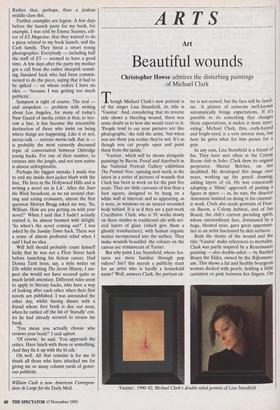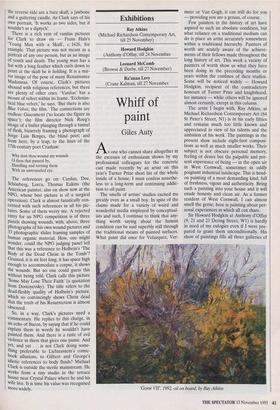ARTS
Art
Beautiful wounds
Though Michael Clark's new portrait is of the singer Lisa Stansfield, its title is Nanitas'. And, considering that its reverse side shows a bleeding wound, there was some doubt as to how she would react to it. 'People tend to say your pictures are like photographs,' she told the artist, 'but when you see them you realise they're not. It's as though you cut people open and paint them from the inside.'
`Vanitas', which will be shown alongside paintings by Bacon, Freud and Auerbach in the National Portrait Gallery exhibition The Portrait Now, opening next week, is the latest in a series of pictures of wounds that Clark has been at work on for the past five years. They are little canvases of less than a foot square, designed to be hung on a white wall at intervals and so appearing, as it were, as windows on an unseen wounded body behind. It is as if they are a part-work Crucifixion. Clark, who is 39, works slowly on these studies in traditional oils with sev- eral layers of glaze (which give them a ghostly translucence), with human organic matter incorporated into the surface. They make wounds beautiful: the colours on the canvas are reminiscent of Turner.
But why paint Lisa Stansfield, whose fea- tures are more familiar through pop videos? Isn't this merely a publicity stunt for an artist who is hardly a household name? Well, answers Clark, the portrait sit- ter is not named, but the face will be famil- iar. 'A picture of someone well-known automatically brings expectations. If it's possible to do something that changes those expectations, it makes it more inter- esting.' Michael Clark, thin, curly-haired and bright-eyed, is a very intense man, but here he gives what for him passes for a grin. In any case, Lisa Stansfield is a friend of his. They have met often at the Colony Room club in Soho. Clark drew its original proprietor, Muriel Belcher, on her deathbed. He developed this image over years, working up the pencil drawing, adding layers of oil. He was consciously adopting a 'filmic' approach of putting a figure in space — as, he says, the director Antonioni insisted on doing in his cinemat- ic work. Clark also made portraits of Fran- cis Bacon, a Colony habitué, and of Ian Board, the club's current presiding spirit, whose extraordinary face, dominated by a huge, bloated nose, gave great opportuni- ties to an artist fascinated by skin surfaces.
Both the theme of the wound and the title `Vanitas' make references to mortality. Clark was partly inspired by a Renaissance painting — also double-sided — by Barthel Bruyn the Elder, owned by the Rijksmuse- urn. This shows a fat and healthy bourgeois woman decked with pearls, holding a little carnation or pink between her fingers. On Vanitas; 1990-92, Michael Clark's double-sided portrait of Lisa Stansfield the reverse side are a bare skull, a jawbone and a guttering candle. As Clark says of his own portrait, 'It works as two sides, but it wouldn't as a diptych'.
There is a rich vein of vanitas pictures for Clark to draw on — Frans Hals's 'Young Man with a Skull', c. 1626, for example. That picture was not meant as a Portrait of any one person, but as an image of, youth and death. The young man has a hat with a long feather which curls down to Point at the skull he is holding. It is a mir- ror image of the pose of many Renaissance Madonnas. Of course, Clark's pictures abound with religious references, but there are plenty of other ones. `Vanitas' has a mount of velvet within its frame. 'Ecclesias- tical blue velvet,' he says. 'But there is also Blue Velvet, the film.' The connections are endless: Giacometti (to locate the figure in Space'); the film director Nick Roeg's image of a bullet plunging through a tunnel of flesh, bizarrely framing a photograph of Jorge Luis Borges, the blind poet; and from here, by a leap, to the lines of the 17th-century poet Crashaw:
Why dost thou wound my wounds
0 thou that passest by, Handling and turning them With an unwounded eye.
The references go on: Cardan, Dee, SchOnberg, Lorca, Thomas Eakins (the American painter, also on show now at the NPG, whose best picture is of a surgical Operation). Clark is almost fanatically con- cerned with such references in all his pic- tures. Some of them worry me. A rejected catty for an NPG competition is of three Panels showing wounds, with, above, three Photographs of his own wound pictures and 33 photographic slides framing samples of human organic material. How, one might wonder, could the NPG judging panel tell that this was a reference to Holbein's 'The Body of the Dead Christ in the Tomb'? Granted, it is six feet long, it has space high enough to accommodate a corpse, it shows the wounds. But no one could guess this Without being told. Clark calls this picture Some May Lose Their Faith' (a quotation from Dostoyevsky). The title refers to the dead-fleshly quality of Holbein's picture, Which so convincingly shows Christ dead that the truth of his Resurrection is almost Obscured.
So, in a way, Clark's pictures need a commentary. He replies to this charge, in an echo of Bacon, by saying that if he could explain them in words he wouldn't have Painted them. And there is a taste of evil violence in them that gives one pause. And yet, and yet . . is not Clark doing some- thing preferable to Lichtenstein's comic- book allusions, to Gilbert and George's idiotic references to body fluids? Michael Clark is outside the sterile mainstream. He works from a tiny studio in the terrace house near Crystal Palace where he and his Wife live. It is time his value was recognised more widely.



























































 Previous page
Previous page